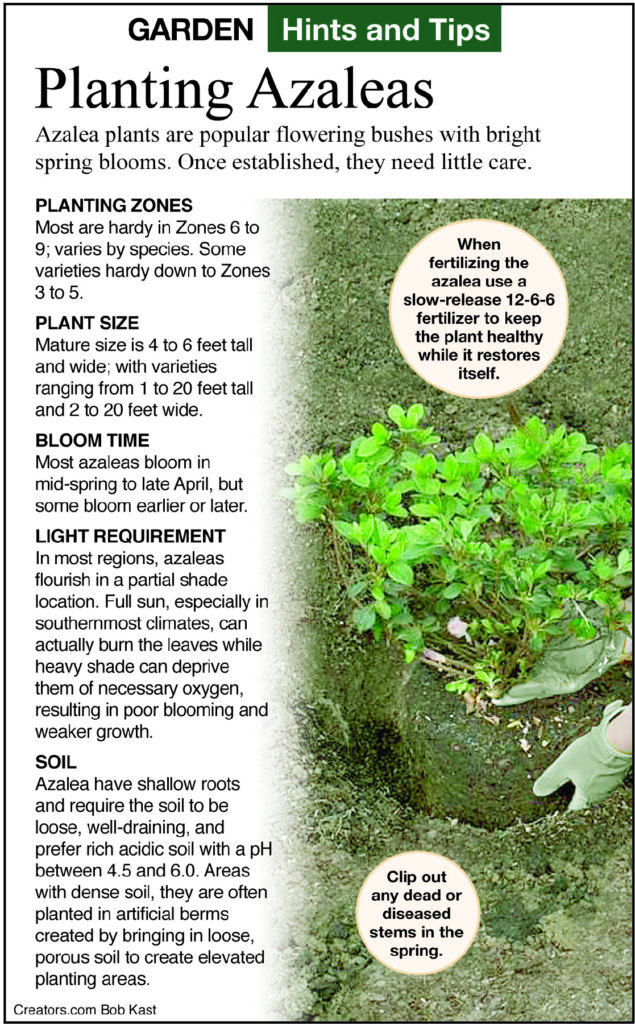Search Posts
Recent Posts
- Rhode Island Weather for June 1, 2025 – Jack Donnelly June 1, 2025
- To Do in RI: 26th Annual Rose Show of the Rhode Island Rose Society June 1, 2025
- Victory is ours: Victory gardens are blossoming again – Chuck Norris June 1, 2025
- Ask Chef Walter: The problem with “The Best” – Chef Walter Potenza June 1, 2025
- Gimme’ Shelter: Kava is waiting at the Providence Animal Control Center June 1, 2025
Categories
Subscribe!
Thanks for subscribing! Please check your email for further instructions.

The Greener View: Azalea Care – Jeff Rugg
by Jeff Rugg, contributing writer
Q: What do you need to do to prepare a flower bed to plant azaleas?
A: Azaleas are members of the rhododendron family. There are over 900 species and hundreds more natural and man-made varieties. Some are native to swamps and some to dry woodlands. Others are naturally found and grow well in sandy soil near oceans, and some are native to mountainous areas.
The eastern United States has dozens of native species, and many were introduced into garden cultivation almost as soon as the smallest villages were developed. The Gulf and Atlantic states and the Pacific Northwest are the best areas to grow rhododendrons in the States. There are azalea species that are winter hardy to any area of North America where shrubs can grow, but there are many more varieties and flower colors available in warmer climates.
Except for the azaleas that naturally grow in swamps, they all need two things: good drainage and acidic soil. Most of them should not be planted in low areas where they will stay waterlogged or on top of a hill where they will dry out too fast. The best soil amendment to add to the flower bed is peat moss. If your landscape has good garden soil, to begin with, then add as much as 50% peat moss.
If you live in an area with a high natural limestone content, such as most of the middle portion of the country that was not listed above as good places to grow azaleas, then you can go as high as 100% peat moss. This means replacing all the soil in the bed, but that may not work if the surrounding soil will not allow for drainage. In that case, the azalea bed should be a raised bed. A bed of 100% peat moss may need to be replaced every decade or two as the peat moss decays away. That is a lot of work. It may be better to find some other shrub to plant.

Q: The leaves on my azaleas have turned yellow. What can I do to fix them?
A: All of the rhododendron family plants need acidic soil, which means a low pH. Iron is used to make chlorophyll. If there isn’t enough acid in the soil, the iron that is in the soil will not be available to the plant. A plant deficient in iron will display a very typical pattern of yellow leaves. The newest growth may be entirely yellow. The older leaves will be yellow but will have green veins. The oldest leaves may just be yellow on the edges.
Soils in low rainfall areas often have a high pH, making them unsuitable for growing healthy azaleas.
The short-term immediate solution is to apply a soluble iron formulation directly to the plant’s leaves. Then apply more to the root system. Your local garden center should have products with chelated iron or liquid iron. Follow the label directions. Too much is harmful to the plant.
The better long-term solution is to maintain the soil so that it retains an acidic pH of between 5 and 6. If possible, add peat moss to the soil. Use it as mulch around the plants. Apply aluminum sulfate to the soil and use fertilizers that say they will acidify the soil or say that they are made for azaleas, camellias, rhododendrons and pin oaks. Again, follow the label directions as too much is harmful to the plants trying to grow roots in that soil.
Email questions to Jeff Rugg at info@greenerview.com. To find out more about Jeff Rugg and read features by other Creators Syndicate writers and cartoonists, visit the Creators Syndicate website at www.creators.com.
COPYRIGHT 2023 JEFF RUGG, DISTRIBUTED BY CREATORS
